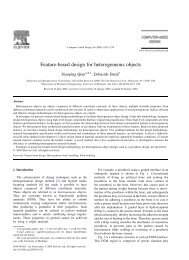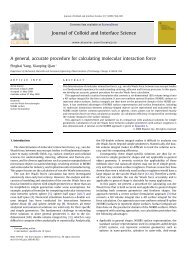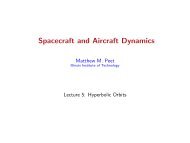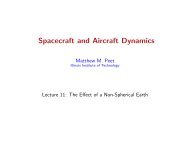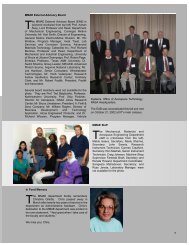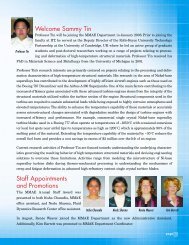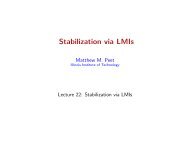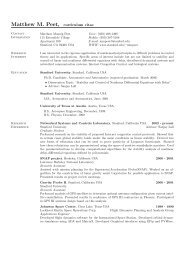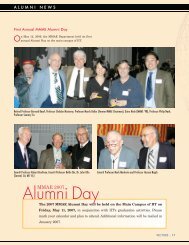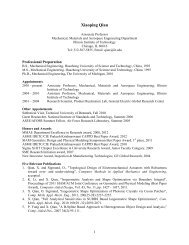Lecture 3 - Illinois Institute of Technology
Lecture 3 - Illinois Institute of Technology
Lecture 3 - Illinois Institute of Technology
Create successful ePaper yourself
Turn your PDF publications into a flip-book with our unique Google optimized e-Paper software.
Spacecraft and Aircraft Dynamics<br />
Matthew M. Peet<br />
<strong>Illinois</strong> <strong>Institute</strong> <strong>of</strong> <strong>Technology</strong><br />
<strong>Lecture</strong> 3: Airfoils, and Static Stability
Aircraft Dynamics<br />
<strong>Lecture</strong> 3<br />
In this lecture, we will discuss<br />
Airfoils:<br />
• Nomenclature<br />
◮ Chords, Camber, Aerodynamic Center, etc.<br />
• Forces and Moments produced by lifting surfaces<br />
◮ Lift and Moment coefficients and how to interpret them.<br />
Static Stability:<br />
• Definition<br />
• How to determine static longitudinal stability<br />
M. Peet <strong>Lecture</strong> 3: 2 / 36
Next Subject: Lifting Surfaces<br />
How do they work???<br />
Figure: Airfoil as Cross-Section<br />
Many <strong>of</strong> the Forces on an aircraft are produced by Lifting Surfaces.<br />
• Major exception is propulsion.<br />
Lifting surfaces are characterized by<br />
Planform Shape: The shape <strong>of</strong> the wing when viewed from above.<br />
• Surface area, tapering, etc.<br />
• determines magnitude <strong>of</strong> forces.<br />
Airfoil: The cross-section <strong>of</strong> the wing.<br />
• Determines type <strong>of</strong> forces and moment.<br />
◮ Positivity, location, etc.<br />
M. Peet <strong>Lecture</strong> 3: Nomenclature 3 / 36
Lifting Surfaces<br />
Planform Shapes<br />
Planform Shape: The planform shape <strong>of</strong> the wing will<br />
affect<br />
• Lift<br />
• Drag<br />
• Moment<br />
Surface Area: As mentioned earlier, forces and<br />
moments are proportional to.<br />
F ∼ = C L QS<br />
and<br />
M ∼ = C M QSl<br />
Thus<br />
• Larger wings produce more lift and drag<br />
• Larger wings produce more Moment<br />
• More on chord length, l, shortly<br />
M. Peet <strong>Lecture</strong> 3: Nomenclature 4 / 36
Lifting Surfaces<br />
Planform Definitions<br />
In this course, we will assume a rectangular wing planform.<br />
Correction factors can be used for rounded or swept-wing configurations.<br />
Chord, c: The width <strong>of</strong> the surface at some point. This determines the size <strong>of</strong><br />
the airfoil.<br />
Root Chord, c r : The width <strong>of</strong> the surface where joined to the airplane.<br />
Tip Chord, c t : The width <strong>of</strong> the surface at free-stream.<br />
M. Peet <strong>Lecture</strong> 3: Nomenclature 5 / 36
Lifting Surfaces<br />
Planform Definitions continued<br />
Span, b: The total length <strong>of</strong> the surface.<br />
Quarter-Chord Line: The line connecting the points <strong>of</strong> 1/4 chord along the<br />
span <strong>of</strong> the surface. The 1/4 chord point is approximately the aerodynamic<br />
center <strong>of</strong> an airfoil - to be discussed<br />
Sweep: The angle the 1/4-chord line makes with the horizontal.<br />
M. Peet <strong>Lecture</strong> 3: Nomenclature 6 / 36
Lifting Surfaces<br />
Examples<br />
M. Peet <strong>Lecture</strong> 3: Nomenclature 7 / 36
Lifting Surfaces<br />
Examples<br />
M. Peet <strong>Lecture</strong> 3: Nomenclature 8 / 36
Lifting Surfaces<br />
Examples<br />
M. Peet <strong>Lecture</strong> 3: Nomenclature 9 / 36
Lifting Surfaces<br />
Examples<br />
M. Peet <strong>Lecture</strong> 3: Nomenclature 10 / 36
Lifting Surfaces<br />
Examples<br />
M. Peet <strong>Lecture</strong> 3: Nomenclature 11 / 36
Lifting Surfaces<br />
Examples<br />
M. Peet <strong>Lecture</strong> 3: Nomenclature 12 / 36
Lifting Surfaces<br />
Airfoils<br />
Figure: Airfoil with positive camber<br />
Chord Line: A line connecting the leading edge to the trailing edge.<br />
Camber Line: A line connecting the points halfway between the top and<br />
bottom surfaces.<br />
Camber: Camber refers to the difference between the chord line and the<br />
camber line. Camber determined the moment produced by a wing. Most wings<br />
have positive camber.<br />
M. Peet <strong>Lecture</strong> 3: Nomenclature 13 / 36
Airfoils: Aerodynamic Center<br />
Aerodynamic Center: The point at<br />
which the pitching moment does not<br />
vary with angle <strong>of</strong> attack.<br />
• Convenient since C M is now static.<br />
• Typically located at the 1/4-chord<br />
line.<br />
Forces and Moments: The motion <strong>of</strong> air creates forces and moments.<br />
• Lift and Drag are measured at the aerodynamic center.<br />
• Moment is measured as the moment about the aerodynamic center.<br />
• Usually take standard form<br />
L = C L QS, D = C D QS, and M = C M QSl<br />
• C L and C D will depend on angle <strong>of</strong> attack and airfoil geometry.<br />
• C M will (hopefully) depend only on airfoil geometry, especially camber.<br />
M. Peet <strong>Lecture</strong> 3: Nomenclature 14 / 36
Airfoils: Lift Coefficient<br />
Lift is given by<br />
General Form:<br />
L = C L QS<br />
C L = C L0 +C Lα α<br />
where<br />
• C L0 is the lift produced at steady-level flight. We define C L0 = 0 for an<br />
airfoil. However, for the aircraft overall, we want C L0 > 0.<br />
◮ Don’t want to fly nose-up all the time.<br />
• C Lα > 0 is determined by the airfoil type and other factors.<br />
◮ Sweep, planform shape, winglets, Mach number, etc.<br />
M. Peet <strong>Lecture</strong> 3: Nomenclature 15 / 36
Airfoils: Drag Coefficient<br />
D = C D QS<br />
The drag coefficient, C D , <strong>of</strong> an airfoil is related to the lift coefficient, C L . It<br />
can be approximated as<br />
C D = C D0 +KCL<br />
2<br />
where<br />
• C D0 and K are determined by airfoil type and other factors<br />
◮ Mach number, thrust coefficient, etc.<br />
M. Peet <strong>Lecture</strong> 3: Nomenclature 16 / 36
Airfoils: Moment Coefficient<br />
Positive pitching moment is given by<br />
General Form:<br />
M = C M QSl<br />
C M = C M0 +C Mα α<br />
where<br />
• C M0 is the moment produced at steady-level flight. For an airfoil we have<br />
the confusing terminology:<br />
◮ CM0 < 0 for if the airfoil has positive camber.<br />
◮ CM0 > 0 for if the airfoil has negative camber.<br />
• For the aircraft overall, we typically want C M0 > 0 (negative camber), but<br />
most airfoils have positive camber.<br />
• By definition C Mα = 0 for an airfoil if we are considering moment about<br />
the aerodynamic center. We will next discuss the effect <strong>of</strong> C Mα on the<br />
overall airplane.<br />
M. Peet <strong>Lecture</strong> 3: Nomenclature 17 / 36
Airfoils: Examples<br />
Low-Speed Airfoils<br />
M. Peet <strong>Lecture</strong> 3: Nomenclature 18 / 36
Airfoils: Examples<br />
Earl Airfoil Evolution<br />
M. Peet <strong>Lecture</strong> 3: Nomenclature 19 / 36
Airfoils: Examples<br />
Figure: Later Airfoils<br />
M. Peet <strong>Lecture</strong> 3: Nomenclature 20 / 36
Big Idea: Static Stability<br />
We now introduce the poorly-defined notion <strong>of</strong> static stability.<br />
Static Stability is stability <strong>of</strong> the equations <strong>of</strong> motion for if we only consider 2<br />
dimensions and consider the body-fixed frame to be inertial.<br />
We have the following three varieties, in order <strong>of</strong> interest:<br />
Static Longitudinal Stability: “Pseudo-stability” <strong>of</strong> the pitching dynamics.<br />
Only motion in the q-direction.<br />
Static Directional Stability: “Pseudo-stability” <strong>of</strong> the yawing dynamics. Only<br />
motion in the r-direction.<br />
Static Roll Stability: “Pseudo-stability” <strong>of</strong> the roll dynamics. Only motion in<br />
the p-direction.<br />
M. Peet <strong>Lecture</strong> 3: Nomenclature 21 / 36
Static Longitudinal Stability:Conceptual Description<br />
Equilibrium<br />
Longitudinal or pitching stability is the most common question we consider. The<br />
dynamics are very simple<br />
where<br />
• I is a moment <strong>of</strong> inertia term.<br />
• Recall q = ˙α<br />
Equilibrium occurs when<br />
M = I ˙q = I¨α = (C M0 +C Mα α)QSl<br />
˙q = ¨α = (C M0 +C Mα α) QSl<br />
I<br />
= 0.<br />
Thus the equilibrium point is<br />
α = − C M0<br />
C Mα<br />
.<br />
M. Peet <strong>Lecture</strong> 3: Nomenclature 22 / 36
Static Longitudinal Stability: Conceptual Description<br />
Nose-Up Configuration<br />
Regarding the equilibrium point<br />
α E = − C M0<br />
C Mα<br />
.<br />
• Typically, we prefer an aircraft with nose-up in steady-level flight.<br />
◮ An aircraft is “nose-up” when α > 0.<br />
• Steady-level flight means an aircraft in equilibrium.<br />
Thus, when designing an aircraft, we want α E > 0. This is achieved when<br />
Case 1:<br />
• C M0 ≥ 0<br />
• C Mα ≤ 0<br />
Case 2:<br />
• C M0 ≤ 0<br />
• C Mα ≥ 0<br />
In the next slide we will show that for stability, only Case 1 is possible.<br />
M. Peet <strong>Lecture</strong> 3: Nomenclature 23 / 36
Static Longitudinal Stability: Conceptual Description<br />
Stability <strong>of</strong> the Equilibrium<br />
For a given equilibrium, the aircraft is<br />
• Stable if a positive displacement results in negative restoring force.<br />
• Unstable if a positive displacement results in a positive force.<br />
M. Peet <strong>Lecture</strong> 3: Nomenclature 24 / 36
Static Longitudinal Stability<br />
Dynamics about the Equilibrium<br />
Stability is about displacement from equilibrium:<br />
∆α(t) = α(t)−α E<br />
Stability Question: Does lim t→∞ ∆α(t) → 0???<br />
The dynamics <strong>of</strong> the displacement, ∆α are<br />
d 2 d2 d2<br />
dt2∆α(t) =<br />
dt2α(t)− dt 2α E = ¨α(t)<br />
= (C M0 +C Mα α(t)) QSl<br />
I<br />
= (C M0 +C Mα (∆α(t)+α E )) QSl<br />
I<br />
C M0<br />
= (C M0 −C Mα +C Mα ∆α(t)) QSl<br />
C Mα I<br />
QSl<br />
= C Mα<br />
I ∆α(t).<br />
Stability always considers displacement from equilibrium!!!<br />
M. Peet <strong>Lecture</strong> 3: Nomenclature 25 / 36
Static Longitudinal Stability<br />
Characteristic Equation<br />
The displacement dynamics are<br />
d 2<br />
dt 2∆α(t) = C QSl<br />
Mα<br />
I ∆α(t)<br />
Thus the characteristic equation is s 2 − CMαQSl<br />
I<br />
, which has roots at<br />
√<br />
CMα QSl<br />
s 1,2 = ± 1 2<br />
I<br />
• We want to know if any roots have positive real part.<br />
Since Q, S, l and I are all positive, there are two cases.<br />
Case 1:<br />
Case 2:<br />
• C Mα ≥ 0<br />
• C Mα < 0<br />
Aircraft is Unstable! Aircraft is Stable, but oscillates.<br />
M. Peet <strong>Lecture</strong> 3: Nomenclature 26 / 36
Static Longitudinal Stability<br />
Using the dC M /dC L Relationship<br />
Sometimes, dC M /dC L data is used instead <strong>of</strong> C Mα = dC M /dα. This can be<br />
done because<br />
Therefore,<br />
C L = C L0 +C Lα α,<br />
C Mα = dC M<br />
dα = dC M<br />
dC L<br />
∗<br />
so<br />
dC L<br />
dα = C Lα.<br />
( ) −1 dCL<br />
= dC M<br />
C Lα<br />
dα dC L<br />
Since C Lα is constant and positive, we have<br />
• Stability if dCM<br />
dC L<br />
< 0<br />
• Instability if dCM<br />
dC L<br />
≥ 0<br />
This is useful if we also want to balance Lift and weight.<br />
M. Peet <strong>Lecture</strong> 3: Nomenclature 27 / 36
Static Longitudinal Stability<br />
Example 1<br />
An aircraft without a tail has the following moment characteristics:<br />
Describe the steady-state motion.<br />
C M0 = −.4 and C Mα = −.2deg −1 .<br />
• C Mα = −.2deg −1 , so aircraft is stable.<br />
• C M0 = −.4, so equilibrium is at<br />
α E = − C M0<br />
= − −.4 deg = −2deg<br />
C Mα −.2<br />
So Equilibrium is Nose Down! The plane will not produce enough lift.<br />
Question: How do we fix the airplane???<br />
Answer: Add a tail.<br />
Question: Alternatives??? Flaps, inclined wings, etc.<br />
M. Peet <strong>Lecture</strong> 3: Nomenclature 28 / 36
Aircraft Incidents: Failure Modes<br />
Short-Period Failure Mode in SAAB Grippen<br />
M. Peet <strong>Lecture</strong> 3: Nomenclature 29 / 36
Aircraft Incidents: Failure Modes<br />
Long-Period? Failure Mode in SAAB Grippen<br />
M. Peet <strong>Lecture</strong> 3: Nomenclature 30 / 36
Aircraft Incidents: Failure Modes<br />
F-22 Longitudinal Mode<br />
M. Peet <strong>Lecture</strong> 3: Nomenclature 31 / 36
Aircraft Incidents: Failure Modes<br />
F-8 Pilot-Induced Oscillation<br />
M. Peet <strong>Lecture</strong> 3: Nomenclature 32 / 36
Aircraft Incidents: Failure Modes<br />
Space Shuttle Pilot-Induced Oscillation<br />
M. Peet <strong>Lecture</strong> 3: Nomenclature 33 / 36
Two Confusing Figures<br />
Confusion: For an airfoil, angle <strong>of</strong><br />
attack is measured to the zero-lift-line.<br />
• Thus C M0 = 0 for an un-inclined<br />
airfoil.<br />
Confusion: We assume that the<br />
aerodynamic center is on the FRL.<br />
• Thus as measure from the CG,<br />
⎡<br />
⃗r ac = ⎣ X ⎤<br />
cg −X ac<br />
0 ⎦.<br />
Z c g<br />
• If there is any confusion on a<br />
problem, ask me to clarify.<br />
M. Peet <strong>Lecture</strong> 3: Nomenclature 34 / 36
Static Longitudinal Stability<br />
Summary<br />
To summarize these two results:<br />
To have static longitudinal stability, we need<br />
• C Mα ≤ 0<br />
To have longitudinal stability AND nose-up in steady state, we need<br />
• C M0 ≥ 0<br />
M. Peet <strong>Lecture</strong> 3: Nomenclature 35 / 36
Next <strong>Lecture</strong>: Finding C M0 and C Mα<br />
The C M0 and C Mα <strong>of</strong> an airplane are determined by adding up the<br />
contributions <strong>of</strong> all factors.<br />
In the next lecture, we will discuss the contributions <strong>of</strong><br />
• Rectangular Wing<br />
• Horizontal Stabilizer<br />
• Canards<br />
M. Peet <strong>Lecture</strong> 3: Nomenclature 36 / 36



